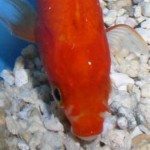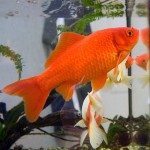The Black Moor goldfish originated in China, where it’s popularly known as ‘dragon eye’, because of its characteristic protruding eyes.
It belongs to the telescope-eye variety of fancy goldfish, which are known for huge eyes jutting out of their heads. This fish is very friendly by nature and easy to maintain, making it one of the most loved aquarium residents the world over.
Black Moor FAQ’s
Eyes: Black Moors are not born with such huge eyes. They develop this unique characteristic as they mature. The eyes of this fish move sideways and not upwards.
Color: Almost always black, the fish may change their color to black, tinged with bronze as they age. Some may even undergo a transformation to rusty-orange on the undersides of their bellies if the water temperature rises.
Scales: They have metallic scales with a velvety appearance, which decreases with age.
Fins: The depth of their body is almost two thirds of its length. This fish is endowed with long, flowing, and delicate fins. The caudal fin is forked and rounded, and the pelvic, pectoral, and anal fins are long and paired. The dorsal fin is half the size of the depth of the body.
Eyesight: The fish has very poor eyesight. It’s eyes are very delicate features, and you need to take extra care to make sure that they don’t get damaged.
Reproduction: They generally breed after a noticeable rise in temperature, at the onset of spring.
Males grow small lumps over their gills and pectoral fins, with which they nudge females and stimulate them to release eggs.
A suitable tank
- A 10 gallon tank, or bigger is suitable for this type of fish.
- The water temperature should be maintained around 60 to 70 degrees fahrenheit.
- Monitor the pH level and maintain it at 7.
- Standard lighting fixtures used for aquariums can be used to provide light.
- Don't put delicate plants in the aquarium. The fish like to dig and may even uproot the plants and feed on them. Either decorate the aquarium with fake plants, or grow plants with sturdy root systems that will be difficult for the fish to uproot.
Feeding your Black Moor
- Feed Black Moor with sinking food pellets. Floating food pellets should be avoided. Because of poor eyesight they find it difficult to hunt for food if it's floating around in the tank.
- Usual goldfish diet. You can also introduce the fish to tiny pieces of oranges, cucumbers, zucchini, blanched lettuce and spinach, peeled grapes and shelled peas. Sludge worms, bloodworms, daphnia, and brine shrimp can also be fed to these fish.
- They are voracious eaters so be extra careful not to overfeed them, and don't feed foods that are too acidic or high in protein and sugar content.
Diseases and Home Remedies
![]() Infections caused by flukes or flatworms cause torn fins and split gills which slowly lose color. Fish may also have trouble breathing.
Infections caused by flukes or flatworms cause torn fins and split gills which slowly lose color. Fish may also have trouble breathing.
Treatment: Prazi Pro for at least a couple of weeks, and give the fish a bath with potassium permanganate added to the water.
![]() Anchor worms and fish lice can also cause infections.
Anchor worms and fish lice can also cause infections.
Treat with potassium permanganate, and a safe formalin alternative plus a salt dip. These are the usual recommendations to treat lice and anchor worms. Click here to find out how to administer a salt bath.
![]() One of the most common diseases is the ich, caused by a parasitic protozoan. The illness is characterized by rapid and shallow breathing, isolation and loss of appetite. The fish appear lethargic and rest at the bottom of the tank.
One of the most common diseases is the ich, caused by a parasitic protozoan. The illness is characterized by rapid and shallow breathing, isolation and loss of appetite. The fish appear lethargic and rest at the bottom of the tank.
Treatment: The infection can be chemically treated like other ailments by using a potassium permanganate or a safe alternative to formalin dip. Black moor can die if Ich is not treated at an early stage.
Most of these problems can be prevented by using correct filtration techniques. Keep the tank clean at all times, and replace it with fresh clean water at regular intervals.
Updated November 2018
You may also like
 Beckett Pumps For Your Aquarium Practically Runs Itself!
Beckett Pumps For Your Aquarium Practically Runs Itself! Building A Backyard Pond? No Prior Experience Is Necessary!
Building A Backyard Pond? No Prior Experience Is Necessary! Goldfish Lays on Bottom of Tank – Causes and Treatment
Goldfish Lays on Bottom of Tank – Causes and Treatment Will Goldfish Survive Winter in an Above Ground Pool? – Considerations to Housing a Goldfish Outside
Will Goldfish Survive Winter in an Above Ground Pool? – Considerations to Housing a Goldfish Outside Is Your Pond Ecosystem Vital For Success?
Is Your Pond Ecosystem Vital For Success? Facts About Goldfish – What You Need To Know About This Opportunistic Feeder!
Facts About Goldfish – What You Need To Know About This Opportunistic Feeder!

